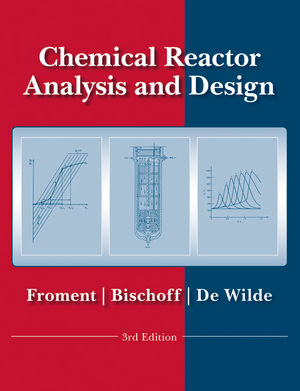|
Textbook
Chemical Reactor Analysis and Design, 3rd EditionISBN: 978-0-470-56541-4
Hardcover
912 pages
August 2010, ©2011
 |
||||||
1.1 Definitions of Chemical Rates.
1.2 Rate Equations.
1.3 Coupled Reactions.
1.4 Reducing the Size of Kinetic Models.
1.5 Bio-Kinetics.
1.6 Complex Reactions.
1.7 Modeling the Rate Coefficient.
Chapter 2: Kinetics of Heterogeneous Catalytic Reactions.
2.1 Introduction.
2.2 Adsorption on Solid Catalysts.
2.3 Rate Equations.
2.4 Complex Catalytic Reactions.
2.5 Experimental Reactors.
2.6 Model Discrimination and Parameter Estimation.
2.7 Sequential Design of Experiments.
2.8 Expert Systems in Kinetics Studies.
Chapter 3: Transport Processes with Reactions Catalyzed by Solids.
Part One Interfacial Gradient Effects.
3.1 Reaction of a component of a fluid at the surface of a solid.
3.2 Mass and heat transfer resistances.
3.3 Concentration or partial pressure and temperature differences.
Part Two Intraparticle Gradient Effects.
3.4 Molecular-, Knudsen-, and surface diffusion in pores.
3.5 Diffusion in a catalyst particle.
3.6 Diffusion and reaction in a catalyst particle. A continuum model.
3.7 Falsification of rate coefficient and activation energy by diffusion limitations.
3.8 Influence of diffusion limitations on the selectivities of coupled reactions.
3.9 Criteria for the importance of intraparticle diffusion limitations.
3.10 Multiplicity of steady states in catalyst particles.
3.11 Combination of external and internal diffusion limitations.
3.12 Diagnostic experimental criteria for the absence of internal and external mass transfer limitations.
3.13 Nonisothermal particles.
Chapter 4: Noncatalytic Gas-Solid Reactions.
4.1 A Qualitative Discussion of Gas-Solid Reactions.
4.2 General Model with Interfacial and Intraparticle Gradients.
4.3 Heterogeneous Model with Shrinking Unreacted Core.
4.4 Models Accounting Explicitly for the Structure of the Solid.
4.5 On the Use of More Complex Kinetic Equations.
Chapter 5: Catalyst Deactivation.
5.1 Types of Catalyst Deactivation.
5.2 Kinetics of Catalyst Poisoning.
5.3 Kinetics of Catalyst Deactivation by Coke Formation.
Chapter 6: Gas-Liquid Reactions.
6.1 Introduction.
6.2 Models for Transfer at a Gas-Liquid Interface.
6.3 Two-Film Theory.
6.4 Surface Renewal Theory.
6.5 Experimental Determination of the Kinetics of Gas-Liquid Reactions.
Chapter 7: The Modeling of Chemical Reactors.
7.1 Approach.
7.2 Aspects of Mass-, Heat- and Momentum Balances.
7.3 The Fundamental Model Equations.
Chapter 8: The Batch and Semibatch Reactors.
Introduction.
8.1 The Isothermal Batch Reactor.
8.2 The Nonisothermal Batch Reactor.
8.3 Semibatch Reactor Modeling.
8.4 Optimal Operation Policies and Control Strategies.
Chapter 9: The Plug Flow Reactor.
9.1 The Continuity, Energy, and Momentum Equations.
9.2 Kinetic Studies Using a Tubular Reactor with Plug Flow.
9.3 Design and Simulation of Tubular Reactors with Plug Flow.
Chapter 10: The Perfectly Mixed Flow Reactor.
10.1 Introduction.
10.2 Mass and Energy Balances .
10.3 Design for Optimum Selectivity in Simultaneous Reactions.
10.4 Stability of Operation and Transient Behavior.
Chapter 11: Fixed Bed Catalytic Reactors.
Part One Introduction.
11.1 The Importance and Scale of Fixed Bed Catalytic Processes.
11.2 Factors of Progress: Technological Innovations and Increased Fundamental Insight.
11.3 Factors Involved in the Preliminary Design of Fixed Bed Reactors.
11.4 Modeling of Fixed Bed Reactors.
Part Two Pseudohomogeneous Models.
11.5 The Basic One-Dimensional Model.
11.6 One-Dimensional Model with Axial Mixing.
11.7 Two-Dimensional Pseudohomogeneous Models.
Part Three Heteorgeneous Models.
11.8 One-Dimensional Model Accounting for Interfacial Gradients.
11.9 One-Dimensional Model Accounting for Interfacial and Intraparticle Gradients.
11.10 Two-Dimensional Heterogeneous Models.
Chapter 12: Complex Flow Patterns.
12.1 Introduction.
12.2 Macro- and Micro-Mixing in Reactors.
12.3 Models Explicitly Accounting for Mixing.
12.4 Micro- Probability Density Function Methods.
12.5 Micro-PDF Moment Methods: Computational Fluid Dynamics.
12.6 Macro-PDF / Residence Time Distribution Methods.
12.7 Semi-Empirical Models for Reactors with Complex Flow Patterns.
Chapter 13: Fluidized Bed and Transport Reactors.
13.1 Introduction.
13.2 Technological Aspects of Fluidized Bed and Riser Reactors.
13.3 Some Features of the Fluidization and Transport of Solids.
13.4 Heat Transfert in Fluidized Beds.
13.5 Modeling of Fluidized Bed Reactors.
13.6 Modeling of a Transport of Riser Reactor.
13.7 Fluidized Bed Reactor Models Considering Detailed Flow Patterns.
13.8 Catalytic Cracking of Vacuum Gas Oil.
Chapter 14:Multiphase Flow Reactors.
14.1 Types of Multiphase Flow Reactors.
14.2 Design Models for Multiphase Flow Reactors.
14.3 Specific Design Aspects.



